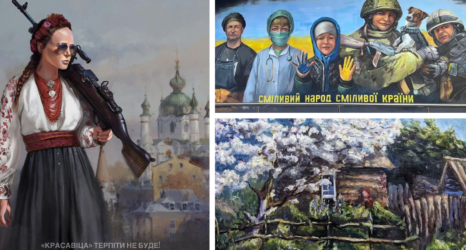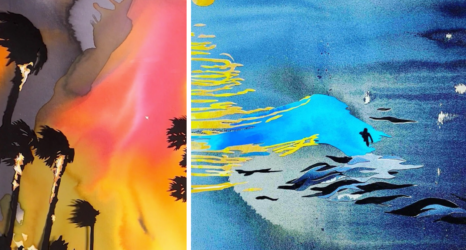“Smile. You just had a big night.”
Tweeting at former Secretary of State and presidential candidate Hillary Clinton in response to her perceived dour appearance after a night of primary wins in March, MSNBC personality and former United States representative Joe Scarborough’s suggestion read to many women as a digital version of the all-too-familiar catcall. For New York-based curator Jenny Mushkin Goldman, Scarborough’s tweet, as well as similar statements from his political pundit colleagues, was a catalyst for the organization of “Smile!”—a vibrant, multigenerational all-women art exhibition on view at Shin Gallery’s Koreatown project space until June 6 that discusses catcalling, gender performance and objectification of women.
The feminist aims of “Smile!” appear unmistakably in Betty Tompkins’ newly created paintings stenciled with the words smile and smile more, part of her vast series based on a crowd-sourced list of words associated with women. While Tompkins’ canvases and Deborah Kass’ “C’mon Get Happy” print directly confront the language of catcalling, other works present a liberating female aesthetic distinctly separate from the male gaze such as Emily Noelle Lambert and Emily Weiskopf’s bright abstract paintings, Rebecca Goyette’s campy cinematic ode to female sexuality “Lobstapus/Lobstapussy” and Hyon Gyon’s towering installation built from traditionally feminine objects like teapots.
I spoke with Mushkin Goldman on her motivation to curate “Smile!,” her own experiences with catcalling and sexism and how art can open an inclusive feminist dialogue.
You mention Joe Scarborough’s now-notorious tweet to Hillary Clinton in the beginning of Smile!’s exhibition description. What initially inspired you to curate an exhibition on this pervasive catcall?
The dialogue has been in the air. It’s in the news especially with the Clinton campaign. This isn’t a show about Hillary Clinton, but that was the catalyst of it. I feel like a lot of women’s issues have been coming up to the surface because of her campaign–the criticism of her appearance and whether she looks angry. It’s highlighting this societal problem we have that a woman is expected to perform for a man. I’ve lived in the city for sixteen years and I’ve never once seen a man told to smile. They’re not expected to smile. It’s not a thing a man has to deal with regardless of what demographic he’s in. But all women have to deal with it, across all races and demographics. It’s unbelievable.
Speaking of the universality of catcalling, I’m sure you have your own catcalling stories. How have your experiences with catcalling influenced your conception of this exhibition?
The catcall is the pinnacle of it, but it’s more than that, especially being in the male-dominated art world. It’s the concept of the smiling pretty assistant–the gallerina–that’s just prevalent. I feel like you have to constantly put up this front of being cheerful, smart but not too smart, pretty, smiling and eager to please. It’s not just the art world, but my personal experiences have been in the art world. Even though there are so many women in art, it’s still dominated by men. I’ve been dealing with a lot of these issues personally since I had a baby. I found the world to be very easy as a single 20-something with no child. I wasn’t even aware of some of the sexism, but once I became a different category of woman, I felt like an inconvenience. I heard other horror stories from women and they kept piling up.
“Smile!” is just the tip of the iceberg. That’s almost the public front. It’s on the street and those are the tweets, but there are so many more serious concerns.
“Smile!” showcases a diverse group of women who are not only varied in their ages and backgrounds, but also their artistic mediums. How did you approach selecting the artists?
The first thing that came to mind was that I wanted color. I wanted this to be a declaration of happiness but coming from within. It’s not all happiness, but allowing a woman to be herself–emotional. I keep saying, “Hey buddy, I’m not smiling for you. I smile because I feel like it.” I wanted to get bold, powerful, unapologetic and exuberant works. To me, I don’t feel tied down when I think of the arts by medium. I started thinking of artists that I admired and it came together.
It’s a striking choice to use an art exhibition to tackle feminist issues like sexism and catcalling. How do you think art specifically can combat the objectification of women?
I think it’s one of the more impactful ways of addressing it. If you draw people in with the attractiveness of bright colors, funny videos and “C’mon Get Happy,” you can make them think because you’ve lured them in. Art lures people in whereas a didactic speech could turn people away. Your ears can turn off, but you can’t really close your eyes. I think this work takes itself seriously, but doesn’t at the same time. It allows people to come into the gallery who don’t know about art and just have a dialogue with it. You don’t have to have a PhD or even an understanding of feminist art. My own mother came to see it and she was laughing–a little bit embarrassed–but that’s the point. I think art has a way of interacting with people that nothing else does. It’s a full sensory experience.
All photos courtesy of the author and the gallery. “Smile!” is on view at Shin Gallery’s project space at 315 5th Ave at 32nd street until June 6 by appointment only. Email info@shin-gallery.com for an appointment.





